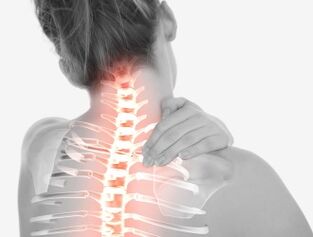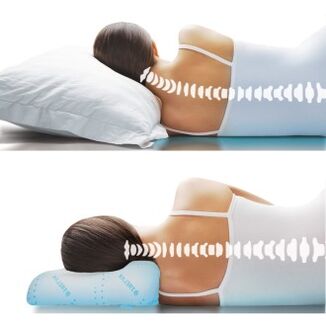
Diseases of the spine are unpleasant in themselves, but they pose the greatest danger if they affect the cervical region.
Even such a seemingly harmless pathology asOsteochondrosis of the cervical region, can provoke the appearance of headaches, difficulty in blood circulation, impaired work of internal organs.
In the absence of treatment, osteochondrosis can lead to the development of other, more serious diseases.
To avoid this outcome, you need to carefully monitor your health and see a doctor when the first symptoms of osteochondrosis appear.
Fortunately, modern medicine has methods that allow this disease to quickly and effectively treat this disease.
What is it
Cervical osteochondrosis is a pathology in whichSoft intervertebral pulp turns into a ossed fabric.Moreover, blood vessels and roots of nerves are involved in the pathogenesis.Osteochondrosis of the cervical region has the ability to disguise themselves for various disorders.
Clinical picture
A distinctive feature of cervical osteochondrosis is pain in the neck, head, upper back.Patients can complain about dizziness, lack of air, jumps in blood pressure, nausea, numbness of the tongue, loss of consciousness.Often they suspect angina pectoris and other diseases of the cardiovascular system.
Classification
Classification of cervical osteochondrosis can be relative to the degree of development of the disease:
- 1 degree - degenerative -dystrophic changes in the intervertebral discs occur;
- 2 degree - the vertebrae themselves are subject to changes;
- 3 degree - intervertebral hernias appear.
Prevalence and significance
Osteochondrosis of the cervical spine “gets younger” literally before our eyes.An examination of patients of different ages that have a tendency to osteochondrosis showed that in current youth problems with the spine arise much earlier (sometimes the first symptoms of the disease appear in adolescence) than representatives of the older generation of the family.
People who were born 60-70 years ago contact clinics about osteochondrosis in mature and old age, although people who were born 20-40 years ago get sick of osteochondrosis even at a young age.This trend is evidence of a significant deterioration in the health of the young generation caused by a decrease in the quality of nutrition and a sedentary lifestyle.
Clinical manifestations of osteochondrosis are found in about 60 percent of adults living in European countries.It is noted that women get cervical osteochondrosis in 50-55 years old, and men at 45-50 years old.
Risk factors
The chances of getting osteochondrosis increase if available:
- abnormalities of the development of the spine;
- excess weight;
- long physical exertion;
- bad habits (smoking);
- sedentary lifestyle;
- work, which implies the regular impact of vibration on the spine (for example, with drivers of vehicles);
- long stress, excessive nervous tension;
- local hypothermia;
- preceding injuries in the neck and nape;
- Autoimmune pathologies entailing the degeneration of cartilage.
Reasons
The main reasons for the development of osteochondrosis include:
- genetic predisposition;
- disturbed metabolic process;
- weak physical development.
It is difficult to establish the exact cause of the appearance and development of cervical osteochondrosis, becauseThis disease occurs in young and elderly people involved in sports and leading a sedentary lifestyle.
Psychosomatics
The development of cervical osteochondrosis indicates the inability to competently withstand problems.Sometimes people become so strong and confident in their abilities that their stability before adversity is transformed into rigidity and lack of flexibility.In this case, attempts to turn their heads are accompanied by stiffness, convulsions and other unpleasant sensations.
Also, osteochondrosis can develop in people who are afraid of problems and do not know how to cope with them.In this case, the protective reflex of the mammal is triggered, and the head is literally drawn into the shoulders.This provision is considered unnatural, therefore, after some time, the muscles of the cervical region begin to hurt and deform.
Consequences
Decrease in muscle elasticity and flexibility in the joints- Signs of natural aging of the body.However, in patients with osteochondrosis, they appear much earlier than in healthy people.Osteochondrosis can cause the development of migraines, hypertension, diseases of the respiratory system, ischemia of the spinal cord and brain, stroke, etc.
Improper treatment of osteochondrosis is no less dangerousas a lack of treatment.The inept actions of a doctor can lead to a persistent deterioration in well -being or sudden disability.
Symptoms and diagnostic methods
The main signs of osteochondrosis of the cervical region include:
- pain in the back of the head, neck, arm and shoulder, which intensify when sneezing, coughing and minimal load on the arm;
- burning between the shoulder blades, tingling in legs or arms, numbness;
- pain and crunch in the neck that occur during tilting and turns of the head;
- fatigue, weakness;
- fainting and dizziness arising from sharp turns of the head;
- The headaches, which usually begin in the back of the head, spread to the temples and crown.
Other signs of cervical osteochondrosis include noise in the ears, hearing impairment, and a decrease in visual acuity.Sometimes the disease makes itself felt by pulling pains in the heart area.
At the first signs of cervical osteochondrosis, you need to consult a doctor who will conduct a comprehensive examination, will diagnose.In this case, such diagnostic methods as MRI, laboratory studies, ultrasound, ECG can be used.
Treatment
Treatment of cervical osteochondrosis depends on the stage of the disease.If at the first stage there is a sufficiently conservative, wandering treatment, then in the second and third stages the doctor’s task is, first of all, to stop the pain syndrome.Enhanced cases may require surgical treatment intended for decompression and stabilization of vertebrae.
Drugs
People with osteochondrosis of the cervical region can be prescribed:
| Group | Description |
| NSAIDs (non -steroidal anti -inflammatory drugs) | Help to remove swelling and pain. |
| Vasodilative drugs | Contribute to improving blood circulation. |
| Sedatives, muscle relaxants | They are prescribed additionally to facilitate the general condition of the patient and reduce doses of the NSAID.Relieve at the same time nervous overstrain and muscle cramps, help to achieve a better therapeutic effect. |
At the end of the course of therapy, the NSAIDs should be purchased for a home first -aid kit, becausePain in the neck can be periodically returned (with stress, overstrain, weather change).Before taking any drugs, consult your doctor.
Surgical treatment
If a positive effect is not observed after a conservative treatment of a conservative treatment, the doctor may recommend the patient spinal fussia.This procedure allows you to immobilize the affected vertebral segment.Its essence is to remove the intervertebral disk, decompression of the nerve root, the installation of the implant or the creation of the physiological height of the disk space.
The operation has a lot of side effects and contraindications.So, it can cause vertebrogenic disability.That is why surgery is carried out in extreme cases.
Exercises, exercise therapy, massage
Massage with cervical osteochondrosis allows you to achieve noticeable improvements.It is important that the procedure is performed by a professional: inept movements in the area of the cervical spine can aggravate the situation.Movements should affect the collar zone, the cervical region and part of the back.

Massage for osteochondrosis implies the alternation of the following actions.
- Stroking.The masseur affects the surface layers of the skin, moving from the head to the upper third of the middle of the back.At the same time, palms or fingertips work.
- Squeezing.Deep layers of the skin located in the upper third of the back are exposed.In this case, the index and thumb of the hands across the neck are carried out to take the skin.Fabrics adjacent to the vertebrae are not involved in this process.
- Trituration.It is carried out to warm up the skin, increase blood flow in the collar area.The procedure must be performed extremely carefully.It is forbidden to influence the spinous processes of the vertebrae.Sometimes rubbing is replaced with circular strokes or movements resembling sawing.
- Kneading.It affects deeply lying fabrics, therefore it has a limited value.It can aggravate the pathology.
During massage, the patient should lie on his stomach, in extreme cases, sit.
Also useful for cervical osteochondrosis may be LFK.Regular classes contribute to strengthening the muscle corset, reducing the load on the cervical spine.You can practice exercise therapy at any stage of pathology, as well as for prevention.During exacerbations, the complex is performed with particular caution.
Standard exercises for the treatment of cervical osteochondrosis are:
- turns of the head from side to side;
- Tilts of the head back and forward;
- Raising the shoulders with fixed or relaxed hands with their hold in this position from 15 to 20 seconds;
- Following the extensors and flexors of the neck, when the head is in a fixed position.
Each exercise is repeated five to seven times.The lesson continues for 15-20 minutes.The set of exercises should be selected by the LFK specialist, taking into account the stage of the disease and the condition of the patient.
Home treatment
Treatment of osteochondrosis at home is rarely practiced, for example, at the first stage of the disease.
In this case, the patient is recommended:
- adjust the posture;
- Correctly equip a workplace;
- do simple physical exercises, includingat the workplace.
A positive impact on the musculoskeletal system will have the use of vitamins and minerals, an increase in motor activity, as well as swimming.
Prevention

For the prevention of the disease, it is recommended:
- sleep on an orthopedic pillow and mattress;
- take a hot shower daily for 10 minutes;
- visit a bathhouse or sauna (relieves cramps of the neck muscles);
- avoid sharp tilts and turns of the head;
- walk more on foot, do yoga and swimming;
- with “sitting” work, make five -minute breaks every hour (you need to walk during breaks, tilts with a body and head in different directions);
- Avoid increased load on the spine: classes with weights, jumps, running;
- choose chairs and chairs supporting the spine;
- abandon addictions, such as smoking, alcohol abuse;
- Drink at least one and a half liters of water per day.
Eating with cervical osteochondrosis is recommended often (at least five times a day) and in small portions.Preference should be given to steamed or cooked dishes.Salads need to be seasoned with olive oil.
Forecast of recovery
The forecast for qualified and timely treatment is a favorable, however, much depends on the age of the patient, the severity of manifestations and the stage of the disease.It is also important in which the person performs medical recommendations regarding nutrition, lifestyle, and eliminate bad habits.
Conclusion
Thus, in most casesOsteochondrosis of the cervical regionIt is possible to cure.However, it is worth remembering that the disease can return at any time.To prevent this, it is necessary to observe prevention measures and a healthy lifestyle.
In addition, it is worth remembering:
- The cause of osteochondrosis is difficult to establish.
- The symptom of the disease is pain in the back of the head and neck.
- The cervical osteochondrosis is treated comprehensively: drugs (mainly NSAIDs), massages, exercise therapy.























